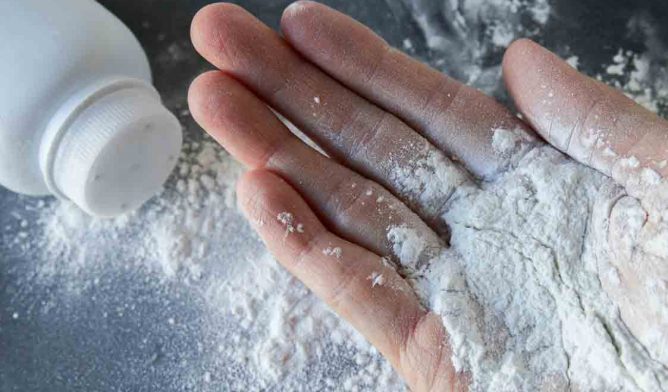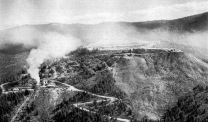Johnson & Johnson Facing Asbestos Talcum Powder Lawsuits
Legislation & LitigationWritten by Matt Mauney | Edited By Walter Pacheco

Recently unsealed documents from a lawsuit against consumer goods and pharmaceutical giant Johnson & Johnson revealed the company knew for decades its talc products may have contained deadly asbestos fibers.
The files show Johnson & Johnson was alerted of asbestos contamination risks in the early 1970s and trained employees to reassure the public its iconic baby powder products were never contaminated with the carcinogenic mineral.
It is the latest chapter in the ongoing controversy over the alleged link between talcum powder and cancer. The lawsuit — filed on behalf of more than 50 women in St. Louis — is among more than 5,000 talc-related claims against J&J.
Most of the lawsuits blame the company’s talc products for causing women to develop ovarian cancer, but previous lawsuits link talc to mesothelioma, a rare cancer caused almost exclusively by exposure to asbestos.
In 2016, a Los Angeles Superior Court jury awarded Philip Depoian $18 million against talc supplier Whittaker, Clark & Daniels. It remains the largest verdict for mesothelioma linked to talcum powder.
The St. Louis-based lawsuit against J&J alleges talc used in the company’s products “is not now, nor has it ever been, free from asbestos and asbestiform fibers.”
Johnson & Johnson Ensures Products are Asbestos-Free
The U.S. Food and Drug Administration (FDA) requires testing to ensure talcum powder products are asbestos free.
In the lawsuit, J& J supplied documents showing tests of its talc dating back to 1972, finding no traces of asbestos.
A statement on the company’s website reads: “Since the 1970s, talc used in consumer products has been required to be asbestos-free, so JOHNSON’S talc products do not contain asbestos, a substance classified as cancer-causing. JOHNSON’S Baby Powder products contain only U.S. Pharmacopeia (USP) grade talc, which meets the highest quality, purity and compliance standards.”
However, federal regulations of cosmetic-grade talc do not exist. The FDA can monitor potential safety problems, but can only take action if sound scientific evidence shows a product is harmful under its intended use.
In 1976, the Cosmetic, Toiletry and Fragrance Association (now known as the Personal Care Products Council) asked its members to use asbestos-free talc in their products.
Talc products were popular through the mid-1970s, and many continue to be used today. The natural mineral can be found in many pharmaceuticals and cosmetics as well as in chalk, rubber and ceramics.
Considered one of the world’s softest minerals and coveted for its ability to absorb moisture, talc has been mined from deposits interwoven with asbestos fibers. According to the unsealed documents in the lawsuit, J&J officials expressed concern over possible asbestos contamination from talc mined in Vermont and Italy.
One official suggested the company should start using corn starch in its consumer products instead of talc. A J&J research scientist also reportedly persuaded one of the company’s talc suppliers — the Val Chisone mine in Italy — to stop distributing English-language versions of a 1974 informational booklet that revealed talc from the mine contained trace amounts of asbestos.
“The business threat is that it can raise doubts on the validity of the documentation of purity and safety of talc,” the scientist said in the document.

If you think you were exposed to asbestos using talc, we can help match you with an attorney. Get the compensation you deserve.
Get Help NowHow Asbestos in Talc Can Cause Cancer
Inhaling or ingesting asbestos fibers can lead to serious diseases, including asbestosis, lung cancer and mesothelioma.
Some studies suggest asbestos fibers can accumulate in the ovaries of women, potentially leading to ovarian cancer. Using talc products on the genitals could be to blame, but there is still much debate regarding exposure pathways.
Dr. Barry Castleman, an asbestos risk consultant, told Bloomberg that even trace amounts of asbestos in products such as baby powder can pose a cancer risk.
“It is a problem even if it’s found in small amounts in talc, especially because it’s used by children and women,” Castleman said.
J&J spokesman Ernie Knewitz cited the FDA’s regulations when defending his company in an emailed statement to Bloomberg.
“We are confident that our talc products are, and always have been, free of asbestos, based on decades of monitoring, testing and regulation,” Knewitz said. “Historical testing of samples by the FDA, numerous independent laboratories, and numerous independent scientists have all confirmed the absence of asbestos in our talc products.”
A 2012 study from the FDA found no traces of asbestos in dozens of talc-containing cosmetic products. However, the agency acknowledged the results were not conclusive since only four or the nine requested talc suppliers submitted samples.
According to the statement on J&J’s website, “The company’s sources for talc are routinely evaluated using a sophisticated battery of tests designed to ensure compliance with all global standards.”
Pharmaceutical Giant Continues to Fight Lawsuits
J&J has been held liable by five juries related to links between its talc products and ovarian cancer, including a $417 million verdict in August. In the last two years, the company has been hit with more than $600 million in jury awards.
None of those cases are related to asbestos, however.
The first asbestos-related lawsuit against J&J expected to go to trial involves California resident Tina Herford, who allegedly developed mesothelioma from breathing in the company’s Baby Powder and Shower to Shower products between 1956 and 1993.
Unlike failure-to-warn lawsuits against asbestos insulation manufacturers, who intentionally added the toxic mineral to products, claims against talc companies gives plaintiffs a new angle — negligence in the failure to detect a contaminant and falsely ensuring a product’s safety.
Although Herford’s case is the first set for trial against J&J, there have been several notable asbestos-related verdicts against other talc manufacturers.
In April 2015, a California woman won a $13 million lawsuit against Colgate-Palmolive. The jury ruled Judith Winkel developed mesothelioma from asbestos in the company’s Cashmere Bouquet talcum powder.
That same year, a New York jury awarded $10.55 million in a wrongful death case against R.T. Vanderbilt.
In the record-setting 2016 case against Whittaker, Clark & Daniels, the jury ruled Depoian developed mesothelioma after he was exposed to asbestos-contaminated talc his father brought home from working in a barber shop.






